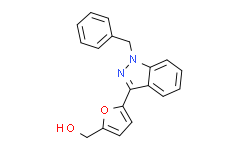Soluble guanylate cyclase (sGC) is a heterodimeric heme protein and the primary NO receptor. Lificiguat (YC-1) binds near or directly to the heme-containing domain of the beta subunit. In the absence of CO, Lificiguat (YC-1) binds with Kd=9-21 μM, depending on construct. In the presence of CO, these values decrease to 0.6-1.1 μM. Lificiguat (YC-1) greatly enhanced CO binding to heterodimeric sGC, as expected (Kd=1 μM). Lificiguat (YC-1) stimulates sGC two- to four-fold in the absence of NO but acts synergistically with CO or NO to achieve several hundred fold activation. Binding of Lificiguat(YC-1) can also overcome inhibitory phosphorylation of sGC. Lificiguat (YC-1) is a soluble guanylyl cyclase (sGC) activator. HCC cell lines HepG2, BEL-7402 and HCCLM3 are incubated for 72 h with Sorafenib and/or Lificiguat (YC-1). Sorafenib or Lificiguat (YC-1) alone inhibits HCC cell proliferation in a dose-dependent manner. Moreover, combination of Sorafenib and Lificiguat (YC-1) significantly suppresses proliferation of HCC cells in a dose-dependent manner. In addition, at the ED50 doses for both Sorafenib and Lificiguat (YC-1), combination index values (CI)=0.93 in HepG2, 0.95 in BEL-7402 and 0.72 in HCCLM3 respectively, suggesting that Sorafenib and Lificiguat (YC-1) synergistically inhibit proliferation of HCC cells.
Medlife has not independently confirmed the accuracy of these methods. They are for reference only.



 扫码关注公众号
扫码关注公众号